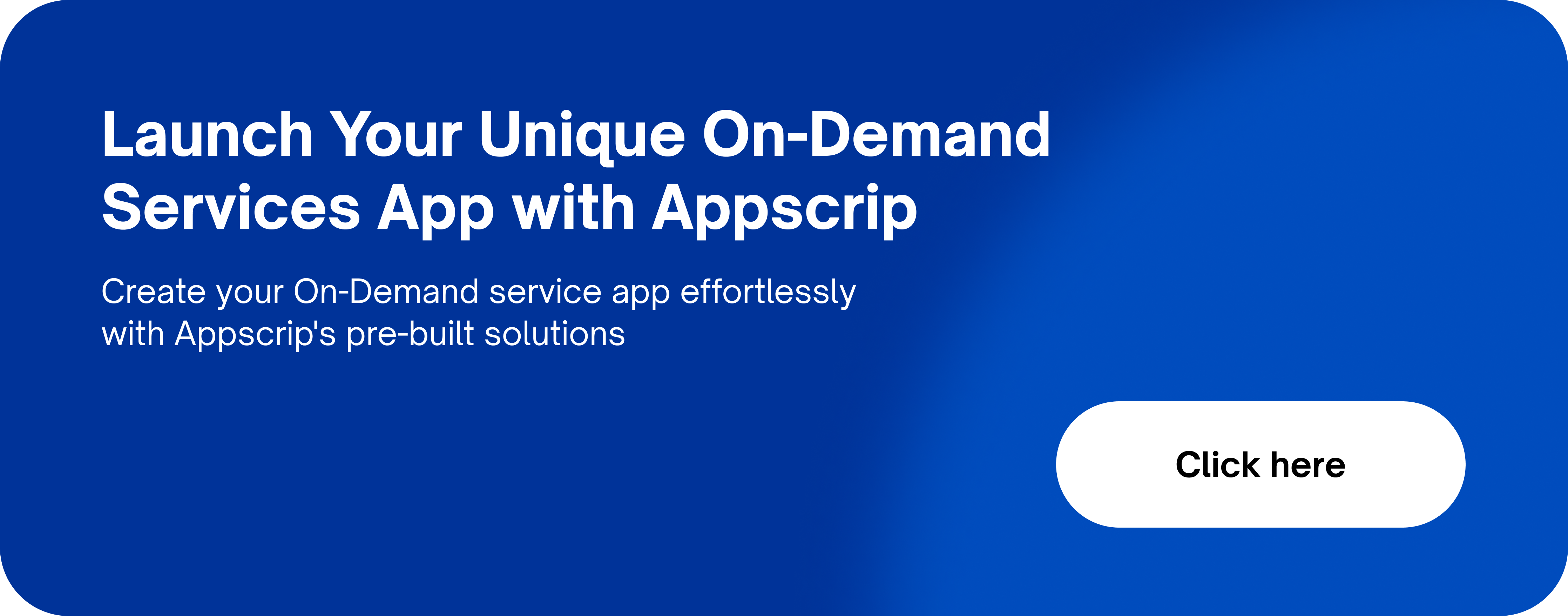We have a few small tasks that require assistance when we’re at home. Things include mending a dripping faucet, washing the automobile, maintaining a spotless home, and protecting our electronic devices. As more and more people look for trustworthy experts who can fix their homes quickly and affordably, the on-demand handyman service market has grown rapidly in recent years.
A successful on-demand handyman clone app development requires meticulous preparation, implementation, and promotion.
Features That Can Be Included In A Handyman Clone App
Here are some features that can enhance the user experience in a handyman clone app.
User Features
User Registration: Allow users to create accounts using their email or social media profiles. This feature provides a personalized experience, enables tracking of service history, and allows users to manage their preferences.
Service Selection: Offer a wide range of services categorized by type, such as plumbing, electrical, carpentry, painting, etc. Users should be able to easily browse and select the specific service they require.
Also display detailed profiles of service providers, including their ratings, reviews, and skill sets so that users can make informed decisions about choosing the right handyman for the job.
Real-time Availability: Enable users to check the availability of service providers in their area. This feature ensures that users can book appointments at their preferred time slots.
Booking and Scheduling: Allow users to book services by selecting the desired date and time. Users should also be able to reschedule or cancel appointments, providing flexibility and convenience.
In-app Chat and Notifications: Provide a chat feature that allows users to communicate with service providers directly within the app. Additionally, send notifications to users regarding appointment confirmations, updates, or any changes in the service status.
GPS Tracking: Integrate GPS functionality to track the location of the service provider in real-time. This feature allows users to monitor the arrival time and stay informed about the service provider’s progress.
Secure Payments: Offer secure and convenient payment options, such as credit/debit cards, digital wallets, or cash on delivery. Implementing a reliable payment gateway ensures a seamless and secure transaction process.
Ratings and Reviews: Allow users to rate and review the service providers based on their experience. This feature helps other users make informed decisions and also encourages service providers to maintain a high level of quality.
Customer Support: Provide customer support through various channels, such as live chat, email, or phone. Users should have a reliable way to seek assistance or resolve any issues they may encounter during the service process.

Handyman Features
Professional Profile Creation: Handymen can create detailed profiles showcasing their skills, experience, certifications, and services offered. This helps customers understand their expertise and choose the right person for the job.
Availability Management: Handymen should be able to update their working hours, mark availability, and manage their schedule within the app. This prevents double-booking and ensures they can plan their workload effectively.
Job Notifications: The app can send real-time notifications to handymen when a new job is posted or when they are selected for a job. This helps them respond quickly to potential opportunities, they should also have the option to accept or reject the job request.
In-app Messaging: A messaging feature allows handymen to communicate with clients directly. This is useful for discussing job details, negotiating prices, or providing updates on the work progress.
Navigation and Maps Integration: Handymen benefit from GPS and maps integration to find the quickest routes to a customer’s location, saving time and fuel.
Quote and Invoice Generation: The app should allow handymen to easily generate quotes for their services and send invoices to customers post-service completion.
Payment Handling: The app must provide a secure and straightforward way for handymen to receive payments for their services. This could include direct bank transfers, digital wallets, or payment upon job completion.
Earnings Tracker: A feature to track earnings, including daily, weekly, and monthly income, can help handymen manage their finances and understand their business performance.
Job Management: Tools to manage ongoing jobs, including time tracking, task checklists, and status updates, help handymen stay organized and efficient.
Admin Features
Dashboard: A comprehensive dashboard provides the admin with an overview of the platform’s operations, including active jobs, number of users, earnings, and more. It should offer real-time analytics and insights to help the admin make informed decisions.
User Management: This feature allows the admin to manage both the customers and providers. Admins can view profiles, approve or disapprove them, and handle user-related queries and issues.
Service Provider Verification: The admin should have the tools to verify the credentials and backgrounds of the service providers to maintain the trust and safety of the platform.
Category Management: The admin can add, edit, or remove service categories and subcategories as per market needs and demands, ensuring the platform stays relevant and comprehensive.
Commission Settings: The feature to set and adjust commission rates for different services or providers. This includes managing how much the platform earns per transaction.
Financial Management: Overseeing all financial transactions, generating reports, and managing payouts to service providers are essential functions for the admin. The platform includes a payroll administration solution that allows service providers to manage their cash and card earnings and have them directly deposited into their bank accounts.
Ratings and Reviews Moderation: To maintain the quality and reliability of reviews, the admin should be able to moderate reviews and ratings, addressing any false or malicious content.
Marketing Tools: The admin panel should have tools for managing promotions, discounts, and referral programs to attract and retain users on the platform.
Support and Ticketing: Admins need to manage customer support tickets, respond to queries, and resolve issues to ensure user satisfaction and operational efficiency.
Analytics and Reporting: Advanced reporting tools to track the app’s performance metrics, such as user acquisition, service provider activity, revenue, and more, are vital for strategic planning.
How To Make Money With Handyman Clone App Development
Monetizing a Handyman Clone App involves creating revenue streams that capitalize on the platform’s services and user base. Here are different ways to monetize such an app:
Service Commission: The app can charge handymen a fixed percentage or a variable commission on each transaction made through the platform. This is the primary revenue stream for most on-demand service apps.
Subscription Fees: Offer different subscription plans for service providers, giving them benefits like increased visibility, more leads, or additional features. Users might also subscribe for premium features like priority booking or extended customer support.
Featured Listings and Advertisements: Allow Handyman clone app service providers to pay for featured spots that give them more visibility on the app. Additionally, third-party businesses could pay to advertise their products or services within the app. They can also offer a membership or loyalty program where users can pay a recurring fee to access exclusive discounts, perks, or loyalty points.
In-App Purchases: Offer in-app purchases for additional tools or features that could benefit the service provider, such as advanced analytics, marketing tools, or exclusive job leads.
Freemium Model: Provide the app for free with basic features and charge for advanced features. Users can start with a free version and upgrade to a premium version for a fee.
Equipment and Supply Sales: Sell tools, equipment, or supplies that handymen may need, either directly through the app or via affiliate marketing partnerships with hardware suppliers.
Cancellation Fees: Implement a cancellation fee for users who cancel their bookings after a certain period, compensating the service provider for their time and potential lost business.

Necessary Steps For A Handyman Clone App Development
Market Research: Perform comprehensive market research before getting into development. Find out how much of a need there is for handyman services in your desired area. Look at similar applications, figure out what makes them good and bad, and then think of ways to make your own Handyman app stand out.
Identify the Capabilities and Features: Develop a list of must-have features for your app based on your analysis of the industry. A rating and review system, in-app chat, payment processing, service provider profiles, scheduling and booking, and user registration are all standard features. To make your app stand out, think about adding some unique features as mentioned above.
Pick a Business Model: Choose an appropriate business model and monetization strategy for your app. A number of monetization options are at your disposal, including subscription models, charging an admin fee on each transaction, or a mix of the two. Maintain a competitive yet profitable pricing strategy.
Create an Early Version: Build an app’s minimal viable product (MVP) or prototype to demonstrate its core features. Before devoting resources to full-scale development, this basic version can be used for testing and receiving user feedback.
Put Together a Development Team: Choosing a competent group to work on the app’s development is a top priority. The quality of the team’s work shouldn’t suffer because it’s in-house or outsourced.
Bring in top-tier UI/UX designers, developers (both front and back-end), and QA experts. You can also use Handyman clone scripts like GoTaskey to quickly build the app using a pre-built solution.
Picking the Right Platform: It is important to determine if the app will be available on iOS or Android before launching it. A cross-platform solution is another option you have. Think about your target demographic, your budget, and the benefits of each platform.
Development: Build the app according to the features that have been specified. Maintain a smooth operation and an interface that is easy to use. Check for and resolve issues with the app on a regular basis while it is being developed.
Payment Gateway Integration: Make it easier for customers to pay for services by integrating trustworthy payment gateways. Verify that all financial transactions are processed properly and in accordance with current industry norms. Some examples are RazorPay, Paypal and Stripe.
Establish Security Procedures: Make sure your app is as secure as possible because users’ personal information and financial transactions are very sensitive. To safeguard user data and earn their trust, set up stringent security procedures.
Testing: Make sure to test your app extensively across many devices and operating systems. Take care of performance problems as you test for usability and security. You can get great input by doing beta testing with a small group of people.
Launch: It is time to launch the app after you are sure it is stable and functional. Incorporate marketing, user acquisition, and first-user engagement into a well-coordinated launch plan.
Marketing: Create an advertising plan to promote Uber-style handyman apps. To reach your desired demographic, make use of digital marketing platforms, social media, and partners. During the initial launch, provide discounts or promotions to entice users.
Updates and User Feedback: Get people to write reviews and feedback. Make the required revisions and enhancements using this data. Keep up with the market by updating the app often to add new features, fix issues, and improve performance.
Customer Service: Set up a customer care system that can respond quickly to user questions and problems. Your platform’s credibility and the quality of user experiences are enhanced by a solid support system.
Conclusion
Building a platform that satisfies the demands of customers and service providers in the on-demand handyman services business is possible through prioritizing the user experience, security, and continued enhancement.
Appscrip’s Handyman clone app script GoTaskey has a scalable and customizable design with pre-integrated payment processing, live status updates and ability to run promotions. The dashboard allows admins to have a holistic view of bookings, service status, and generated revenue among the other features mentioned above. Contact Appscrip to get your handyman clone app off the ground!










